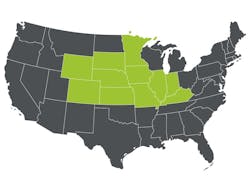View from the top: Joe Pellegrini, president and COO of Great Plains Communications
Joe Pellegrini has a long history of building new telecom ventures, and his role at Great Plains Communications (GPC), a 113-year-old independent telco, is no different.
In January he was promoted to President and Chief Operating Officer, reporting directly to the CEO of Great Plains Communications, Todd Foje.
Pellegrini joined the GPC management team in 2022. In his latest role, Pellegrini leads the company's day-to-day operations, optimizing efficiencies, mitigating risks, enhancing the overall customer experience, and executing the telco’s fiber expansion strategy.
Joe has over 25 years of strategic leadership experience in the telecom industry, including operations, wireless deployment, construction management, GIS mapping, vendor relations, service delivery, digital transformation, and customer experience.
Like other independent telcos, Great Plains Communications (GPC) has developed a multifaceted fiber strategy to serve its broad range of consumer, business, and carrier customers.
“GPC is a 113-year-old company. Over the past 15-20 years including the past five years under Grain Management’s ownership, GPC has stepped forward aggressively into the fiber-fed side of the world,” Pellegrini said.
The service provider is focused on growing through acquisitions and organic network builds utilizing private capital and state and federal funding.
During his tenure with the company, Pellegrini has been helping with efforts to “improve the digital experience, enhance and continue their customer-first focus, and positively grow the business.”
In 2018, Grain Management purchased family-owned Great Plains Communications, further enabling the telco to expand its network and enhance its offerings.
“Grain has a great deal of experience in the telecom space,” Pellegrini said. “They are strong partners and have been instrumental in our growth by securing financing and providing strategic input to support the ongoing success of our company."
Customer experience focus
Having begun his career as a telecom technician and advancing through the ranks to leadership, Pellegrini’s role focuses on enhancing the customer experience.
“When you work with customers from the start of your career, the customer- first focus is always top of mind,” Pellegrini said. “We exist as a business to deliver good quality services that people want to use, get used to using, and prefer to use from our company for years to come. We want to earn their business, their trust and their loyalty by consistently exceeding expectations when it comes to our products and our service experience.”
Serving customers effectively is part of a broader lifecycle issue that starts when a customer signs up for service.
“The continuation of quality of service has to be there day in and day out,” Pellegrini said. “You can’t take a break from it because it’s every day and every hour with each interaction.”
He added that this customer-first attitude applies to GPC’s vast diversity of residential, business, and carrier service customers.
“I was lucky to have a variety of customer experiences early on in my career that continually refined my interactions with the customer and the sales team,” Pellegrini said. “Whether it’s a residential customer in a fiber-to-the-home capacity or a long-term wireless client, we need to care for that relationship and appreciate and respect it daily.”
Fiber expansions continue
Fiber network expansion continues to gain momentum at GPC. The telco uses a mix of private and public funding to conduct new builds.
The GPC team continually researches the best way to leverage public funding, such as the Broadband Equity Access and Deployment (BEAD) program for Nebraska, Indiana, and Iowa.
Pellegrini mentioned success requires a combination of expertise in the regulatory space and fiscal responsibility. “We are very fortunate to have a group that understands government funding programs and policy, but also understands the responsibility to be good stewards of those dollars and deliver on what we said we would do."
GPC takes a two-pronged approach to targeting new markets for its fiber builds. Since the beginning of the year, the service provider has made several expansion announcements in its operating markets in Indiana and Nebraska.
In Southeastern Indiana, GPC built out symmetrical fiber broadband to 1,200 additional homes and businesses in several areas, including Aurora and Vevay. Likewise, in its home state of Nebraska, its ongoing network expansion brings multi-gigabit symmetrical fiber services to over 5,000 additional homes and businesses in rural and larger urban areas including the Omaha suburbs of Gretna, LaVista, Ralston and Papillion. The service provider was also awarded $3.45 million in the Nebraska PSC 2024 reverse auction, enabling it to expand fiber broadband to rural locations in 10 unserved Nebraska communities.
He added that public funding enables GPC to access locations where it cannot make a business case relying solely on its own capital.
“Some of the rural broadband builds are very high-cost and not commercially viable,” Pellegrini said. “Utilizing government funding programs , whether state or federal, enables us to offer fiber broadband services to more unserved and underserved areas that we couldn’t normally reach."
A community partner
When GPC plots out new communities to target with its fiber service, it is vital to talk to community leaders about what it could bring.
“We’ll send a local manager to meet with the mayor, meet with the economic counsel, and show what we offer, and invite their feedback and ask for their support,” Pellegrini said. “We will also show them what we did in neighboring towns.”
Unlike a national company whose headquarters could be in another state across the country, GPC stresses to prospects that they are a local company. Some local technicians live in the communities they serve, volunteering raising families and shopping at local businesses.
Pole attachment realities
While GPC has over 100 years of working inside communities to navigate the permitting process, the influx of requests due to growing migration to fiber-based broadband can pose various challenges. As providers enter new communities, most want to facilitate permitting but access to aerial utility poles remains an issue.
Pellegrini said the pole attachment permitting process has evolved over the past decade.
“We used to do 80x20 builds with 80 percent being aerial and the rest underground,” he said. “We were always able to make the moves with a nominal fee and use contracting companies that pole owners approved to make those changes, and we would build.”
GPC often does network builds that include 10-20 percent aerial on poles and 80 to 90 percent underground.
“Because of the lay of the land in Nebraska, our builds are mostly underground,” Pellegrini said. “In Indiana and other places where you want to go aerial, it is becoming increasingly difficult and expensive.”
Controlling quality
The service provider has over 18,000 fiber miles that they own and manage. They serve nearly 200 communities in Nebraska, Indiana, Colorado and Iowa with residential and enterprise services. The network encompasses Nebraska and extends into Colorado, Illinois, Indiana, Iowa, Kansas, Kentucky, Minnesota, Missouri, Ohio, South Dakota, Wisconsin, and Wyoming. This reach allows GPC to transport traffic for wholesale/carrier and Fiber to the Tower customers over their unique, high-capacity routes- achieving both a national and even global reach.
“We have a large footprint and will continue to expand by building onto or adjacent to our current footprint,” Pellegrini said. “This footprint is our middle mile to control the customer experience since we’re not relying on third-party vendors.”
GPC also has a sizeable and growing 400G network that connects data centers in various markets. Last June, GPC added two new and unique 400-gig capable routes: one between Omaha, Nebraska, and Minneapolis-St. Paul, Minnesota, another between Omaha, Nebraska and Chicago, Illinois.
These connections provide capacity to 400-gig wave service between the 1623 Farnam Data Center in Omaha, Nebraska, and the Data Center at 511 11th Ave. S in Minneapolis-St. Paul, Minnesota and 350 Cermak Rd. in Chicago.
“Our 400G high bandwidth connection enables us to on and off-ramp our connections and to sell to other carriers to connect major metro cities,” Pellegrini said. “We serve major wireless operators and Fortune 500 businesses.”
While GPC is fortunate to be capable of serving multiple channels, whether business, fiber to the home, FTTT or wholesale, the company plans to be thoughtful in how it grows.
“Our approach is to support the quality of the customer experience, above all else,” said Pellegrini.
PROFILE
JOE PELLEGRINI
BACKGROUND:
Joe Pellegrini joined Great Plains Communications (GPC) in 2022. As president and COO of GPC, he is responsible for the company’s day-to-day operations, focusing on optimizing efficiencies, mitigating risks, enhancing the overall customer experience, and executing its ongoing fiber expansion strategy. He comes to the role with 25 years of telecom industry experience in running wireline and wireless network infrastructure. Before coming to GPC, he was COO and EVP of operations for Everstream Solutions. Pellegrini also served as the senior director of wireless deployment at Crown Castle and the former Lightower Fiber Networks, which Crown Castle purchased in 2017. Earlier, he was the director of operations for Fibertech Networks, which Lightower Fiber Networks acquired in 2015.
EDUCATION:
Vermont Technical College
About the Author
Sean Buckley
Sean is responsible for establishing and executing the editorial strategy of Lightwave across its website, email newsletters, events, and other information products.



